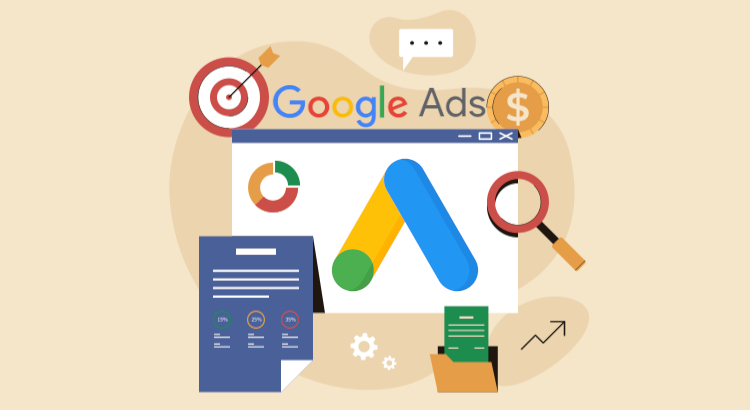Google Ads stands as a powerful tool for businesses to connect with potential customers. Understanding the intricacies of Google Ads is crucial for maximizing its effectiveness. This complete guide is tailored for beginners, providing insights into the key elements that contribute to successful Google Ads services.
What Is Google Ads?
Google developed the search engine marketing platform known as Google Ads, formerly known as Google AdWords. This platform offers the most popular form of PPC advertising. It allows businesses to display ads on Google’s search engine results pages, as well as on its advertising network. Advertisers bid on specific keywords to ensure their clickable ads appear in relevant search results.
Factors That Influence Google Ads
1. Ad Rank
Ad Rank determines the position of your ad on the search results page. It is calculated using your bid, the quality of the advertisement, and the expected effect of ad extensions. Improving Ad Rank requires a strategic approach to bidding and creating high-quality ads.
2. Location
The geographical targeting of your ads influences their visibility. Tailoring your campaign to specific locations ensures that your ads reach the most relevant audience, increasing the likelihood of engagement and conversions.
3. Keywords
Keywords are the foundation of Google Ads. Choosing relevant and specific keywords is essential for connecting with users searching for products or services similar to what you offer. Effective keyword research involves understanding your target audience and competition.
4. Match Types
Google Ads offers different match types to control how closely a user’s search query must align with your chosen keywords. Understanding these match types is crucial for refining your targeting. The four main types are:
- Broad Match: Broad match allows your ad to appear for variations of your keywords, including synonyms and related searches. It offers a broad reach but may lead to less targeted traffic.
- Modified Broad Match: Modified broad match lets you specify certain keywords that must be included in the user’s query. This strikes a balance between specificity and reach.
- Phrase Match: Phrase match targets searches that include your specified keywords in a specific order, offering a more refined targeting approach.
- Exact Match: Exact match is the most precise option, displaying your ad only when the user’s query exactly matches your chosen keywords.
5. Headline and Description
The headline and description of your ad play an important role in attracting users’ attention. Write concise, eye-catching advertising copy that focuses on the unique selling points of your product or service. Utilize keywords naturally to improve relevance and click-through rates.
6. Ad Extensions
Ad extensions enhance the visibility and functionality of your ads. Leveraging various ad extensions can improve the overall performance of your campaigns. The key types of ad extensions include:
- Sitelink Extensions: Sitelinks direct users to specific pages on your website, allowing you to showcase different aspects of your business.
- Call Extensions: Call extensions provide users with the option to call your business directly from the ad, streamlining the conversion process.
- Location Extensions: Location extensions display your business address, making it easier for local users to find and visit your physical storefront.
- Offer Extensions: Offer extensions highlight special promotions or discounts, encouraging users to take immediate action.
- App Extensions: App extensions promote app downloads by providing a direct link to your mobile application.
7. Google Ads Remarketing
Remarketing is a powerful strategy that targets users who have previously interacted with your website or ads. By showing relevant ads to this audience, you can re-engage potential customers and encourage them to complete desired actions, such as making a purchase.
Types of Google Ads
1. Search Ads
These ads appear on Google search results pages when users enter relevant queries. They consist of a headline, description, and link, directly connecting businesses with users actively searching for specific products or services.
2. Display Ads
Display ads include text, image, and rich media formats, appearing on Google’s Display Network. They target users based on their interests and behaviors, showcasing visually appealing content across various websites and apps.
3. Shopping Ads
Designed for e-commerce, Shopping ads display product images, prices, and store names directly in the search results. They allow users to compare products visually and click through to make purchases on the advertiser’s website.
4. Video Ads
Video ads appear on YouTube and the Google Display Network. Advertisers can engage users with compelling video content, building brand awareness, and encouraging viewers to take specific actions, such as visiting a website or making a purchase.
5. App Ads
App ads promote mobile applications across various Google platforms. These ads can appear on Google Search, YouTube, Google Display Network, and within other apps, driving installations and engagement for app developers.
Importance of Google Ads
Why use Google Ads, you might be wondering? Google Ads offers many benefits for businesses seeking success in the competitive online marketplace. Those benefits are:
- Immediate Visibility: Ads appear quickly, providing instant exposure to potential customers.
- Flexibility: Advertisers have control over budgets, targeting, and ad content.
- Precise Targeting: Reach specific demographics, locations, and interests for better-targeted campaigns.
- Remarketing: Re-engage users who have shown interest but haven’t converted.
- Cost-Effective: Pay-per-click model ensures advertisers only pay for actual clicks.
- Measurable Results: Track and analyze campaign performance for data-driven decision-making.
Related Article: Why Is Google Ads Important for Businesses?
How Does Google Ads Work?
1. Advertisers place bid on keywords in Google Ads
Advertisers participate in auctions, bidding on specific keywords relevant to their business. The bid, combined with ad quality, determines ad placement.
2. The potential customer uses Google to search for a keyword
Users initiate the process by entering a search query or keyword into Google’s search bar, seeking information or solutions.
3. Google displays ads for that keyword based on Ad Rank
Google’s algorithm calculates Ad Rank, considering bid, ad quality, and extensions. Relevant ads with higher Ad Rank are displayed prominently on the search engine results page (SERP).
4. The potential customer clicks through to one of the websites listed on the search results
When users click on an ad, they are directed to the advertiser’s website, initiating a potential conversion or engagement.
Related Article: Ways to Maximize Brand Awareness Through Paid Search
How to Set Up Google Ads Campaign?
1. Use a Google Ads planning template
Employing a planning template helps structure your campaign, defining goals, target audience, and messaging strategies. It provides a roadmap for a successful advertising endeavor on Google Ads.
2. Set up your Google Ads account
Establishing a Google Ads account involves providing necessary details, laying the foundation for your advertising initiatives on the platform. It’s the first step in gaining access to Google’s advertising tools.
3. Choose your business name and website
Select a business name and website URL aligned with your brand identity and campaign objectives. This step ensures consistency and reinforces your brand image in your ads.
4. Select your advertising goal
Clearly define your campaign objective, whether it’s driving traffic, generating leads, or boosting sales. This clarity shapes your advertising strategy and campaign structure.
5. Craft your ad
Develop compelling ad copy with attention-grabbing headlines, descriptions, and relevant keywords. Crafting engaging content is crucial for capturing the interest of your target audience and encouraging clicks.
6. Add keyword themes
Identify and incorporate keyword themes resonant with your business. Optimizing your campaign for relevant keywords enhances ad visibility and ensures alignment with user search queries.
7. Set your ad location
Choose specific geographic locations to ensure your ads reach the most relevant audience. Geographic targeting maximizes the impact of your campaign by focusing on areas relevant to your business.
8. Set your budget
Allocate a daily or monthly budget aligned with your advertising goals. Setting a budget ensures effective financial management and allows you to control your advertising costs.
Related Article: PPC Budgeting: How Much Should You Really Spend?
9. Confirm payment
Provide payment details to fund your ads and initiate your campaign effectively. This step is essential for activating your ads and ensuring a smooth start to your Google Ads campaign.
10. Link your Google Analytics account
Integrating Google Analytics provides insights into user behavior, enabling data-driven decision-making. This connection enhances your ability to measure the effectiveness of your ads and understand user interactions.
11. Add UTM codes
Implementing UTM codes allows you to track the effectiveness of your ads. These codes provide detailed analytics on traffic sources, enabling you to assess the performance of different marketing channels.
12. Set up conversion tracking
Defining and tracking conversions, such as form submissions or purchases, gauges the success of your campaign. Conversion tracking provides valuable data for optimizing and refining your advertising strategy.
13. Integrate your Google Ads with your CRM
Connecting your CRM system to Google Ads enables seamless data flow. This integration enhances targeting by providing a comprehensive view of customer interactions, allowing for more personalized and effective advertising.
Conclusion of Google Ads Guide
Mastering Google Ads is a journey that involves understanding the platform’s features, leveraging various ad types, and implementing effective strategies. By grasping the fundamentals outlined in this guide, beginners can embark on successful advertising campaigns and achieve their business objectives.
Frequently Asked Questions
How much does Google Ads cost?
The cost of Google Ads varies based on factors such as competition, industry, and targeting. Advertisers set their budgets and pay per click, with costs ranging from a few cents to several dollars.
How long does it take to see results with Google Ads?
The time to see results with Google Ads depends on factors like industry competitiveness, campaign optimization, and ad relevance. Some businesses may experience immediate results, while others may take a few weeks to see significant changes. Continuous monitoring and optimization are key to achieving long-term success.
What are alternative search engine marketing platforms to Google Ads?
Alternative search engine marketing platforms include Bing Ads and Yahoo Ads. Bing Ads, owned by Microsoft, enables businesses to display ads on the Bing search engine. Yahoo Ads complements this, extending reach to users on the Yahoo search engine. These platforms offer alternatives to Google Ads, providing diverse advertising opportunities.
Can I target specific devices with Google Ads?
Yes, Google Ads allows you to target specific devices such as desktops, mobile devices, and tablets. This level of customization enables advertisers to tailor their campaigns based on the preferences and behaviors of their target audience.
What are the key benefits of using PPC advertising on Google Ads?
PPC advertising services on Google Ads provide immediate visibility, precise targeting, flexibility in budgeting, and measurable results. Advertisers have control over ad content, targeting options, and can track performance through detailed analytics.
How does ad scheduling work in Google Ads?
Ad scheduling, also known as dayparting, allows advertisers to control when their ads are shown. By specifying certain days and times, businesses can optimize their budget by displaying ads when their target audience is most likely to be online.
What is the Google Display Network (GDN)?
The Google Display Network is a collection of websites, apps, and videos where Google Ads can appear. Advertisers can reach a broader audience by displaying their ads on the GDN, targeting users based on demographics, interests, and online behavior.


